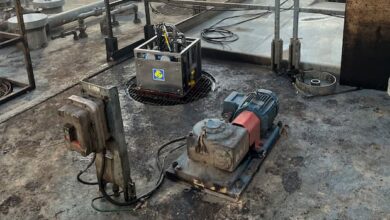Shaped diamond elements minimize lateral vibrations without curtailing drill bit’s efficiency
Chisel-shaped elements demonstrate ability to help PDC bits drill longer, more smoothly in two Delaware Basin studies
By Josh Ramsey, Anadarko Petroleum Company; Anthony Phillips, Caleb Rickabaugh, Joel Gray and Michael Savage, Baker Hughes, a GE company

Drillers are well accustomed to the challenge of lateral instability while drilling at low depth of cut (DOC), particularly if they are drilling with polycrystalline diamond compact (PDC) bits.
The natural vibrations that arise in fixed-blade PDC bits affect bit durability and performance. For example, excessive vibrations may cause the bit and cutting structure to skim across the rock surface. If the bottomhole assembly (BHA) is not designed to control this issue, there is a significant likelihood of damage to the cutters or the BHA through twist-off or tool failures. And while the industry has investigated this problem for years, past technologies to minimize lateral vibrations at the bit while drilling have hindered efficiency.
A new bit technology using a shaped diamond element (SDE) was developed to minimize lateral vibrations while increasing drilling efficiency. As detailed in this article, the technology was first evaluated in laboratory testing, and the most promising candidate was then tested in the field.
Laboratory Testing
Full-scale laboratory evaluation has been used for decades to gauge a PDC bit’s lateral stability during drilling prior to taking it to the field. This particular round of SDE bit screening tests was conducted in an atmospheric testing facility and followed a testing protocol that measured drilling performance at multiple DOC steps.
Previous development tests investigated the performance of conical-shaped diamond elements. The results from these earlier studies were combined with drill bit profiles in a design of experiments to gain a better understanding of bit stability and efficiency.

The conical elements initially showed promise when applied correctly with regards to exposure and placement. However, these elements exhibited durability problems in more rigorous tests, particularly a weakness on their trailing edges that resulted in premature failure.
This led to the development of a chisel-shaped element (Figure 1) with a larger diamond volume behind the leading edge, which would help the diamond remain in compression and increase the element’s durability. In a series of lab tests that compared the performance of the two shaped elements in a dry vertical boring mill, the chisel-shaped element’s diamond edge achieved 114 trips to failure, while the conical element lasted only 51 trips.
The latest testing evaluated the new chisel shape and aimed to identify the ideal placement of the elements to provide the stability benefits without harming the bit’s drilling efficiency. An intentionally unstable 8.75-in., six-blade PDC bit frame (Figure 2a) was designed as a baseline for testing, and a second bit frame was built incorporating the SDE technology (Figure 2b). The second frame also allowed the element count and exposure to be adjusted.
Tests were run to examine the effect of exposure and number of SDEs on the bit’s stability. The testing equipment consisted of a drill stem, PDC bit and the rock. The movement of the drill stem and drill bit were measured with lasers placed on the surface of the rock. The bits were tested at atmospheric pressure in different rocks, which served to indicate bit response in soft and hard formations.
The test protocol called for running the bit at varying DOC steps, which ranged from zero to 0.18 in. per revolution, and with SDE position varied as per Table 1, with test 1 acting as the baseline. As PDC bits tend to be more laterally unstable at low DOC, the SDEs were positioned so that their engagement occurred early in the DOC range.

During tests in a soft limestone, an instability boundary line was determined at 28% lateral instability, with a higher value indicating a more unstable bit. The baseline bit started at 28%, indicating instability at low DOC. As DOC continued increasing, bit stability eventually reached 100%, indicating high instability.
The SDE bits used in tests 2, 4 and 5 all remained stable through the test, independent of DOC, and achieved an instability level of 6% to 8%. Only test bit 3, with the low exposure element, showed no difference in stability response versus the baseline. This led to the conclusion that low exposure provides no stability benefit.
The bottomhole patterns observed for tests 2, 4 and 5 validated that, when properly configured, these elements engage and cut the rock (Figure 3). This initial series of tests indicated that a high exposure is required to engage with the rock and provide the stability benefit.
A second set of laboratory tests was then conducted to determine whether the gain in stability with these SDE bits would have any detrimental effect on efficiency. The tests used a marble-type rock and a full-scale downhole pressure simulator under 6,000-psi confining pressure. The tests were designed to compare performance from one bit to the next over a range of parameters: rotation from 60 to 180 RPM and weight on bit from 10 to 30 klbs. The ultimate aim was to identify the SDE configuration that would minimize losses in both efficiency and aggressiveness.

Test bit 1 again served as the baseline, providing the target efficiency level based on specific energy and aggressiveness. Because test bit 3 provided no stability benefit in the previous testing, it was excluded from these simulator tests.
The results for specific energy correlated to the efficiency levels of the bits. All SDE test bits had a similar efficiency level. However, an analysis of the aggressiveness results showed that test bit 5 demonstrated the lowest reduction in aggressiveness. With the primary goal to improve stability while minimizing efficiency losses, the testing determined that a design like bit 5, with one element per blade, was a good balance for an 8.75-in. bit.
Taking to the field
The lessons learned in the laboratory were then applied to the design of an 8.75-in., seven-bladed PDC bit for use in the Delaware basin. While the existing frame had a full row of backup cutters, the innermost backup cutter was removed to make space for the SDE, which was strategically placed in the required area with one element per blade (Figure 4).

The SDE field test bits were equipped with in-bit sensors to confirm if the operational benefits recorded in the lab were observed in the field. Data from their runs were compared with offsets to quantify the benefit of the SDE technology over a number of months.
An 8.75-in. intermediate vertical interval in the Delaware basin was selected for early field trials. The challenges encountered in this application related to the unpredictability and inconsistencies of the rock. For example, the formations are interbedded with limestone stringers with a UCS range of 10-25 kpsi. Due to these inconsistencies, bit/BHA vibrations are common. Operators will likely experience both stick-slip and bit-whirl in the same run. These vibrations will lead to broken cutters or ring/core out dull conditions. Beyond shortening bit life, these downhole vibrations often lead to tool failures in the BHA.
Case Study 1
The first study was conducted on a series of wells drilled by one operator in Texas between Q2 2016 and Q4 2017. These wells focused on the same target formation, resulting in 61 runs using bits without the SDEs and 80 runs with the SDEs.
The two different sets of runs were compared for the average distance drilled, average ROP and reason pulled. On average, the bits with SDE drilled a distance of 5,581.8 ft, 469.3 ft further than the non-SDE bits and with an average drop in ROP of only 5.5 ft/hr. The drop in ROP can be confidently quantified by breaking down the drilling data of the interval in this application.
As the bits with SDE drilled further, they endured more of the challenging formations at the end of the interval. However, they also exhibited an improvement in dull conditions and were able to continue on to the planned TD. In fact, the SDE bits were pulled less frequently for downhole tool or motor failures, reaching TD 80% of the time – a 21% improvement over the average TD rate with standard PDC bits.
Case Study 2

The second study analyzed downhole vibration data collected by in-bit sensors in the shank to better understand the physics of the drilling. Two bits, a standard PDC and a bit containing the SDE technology, were utilized on the same drilling pad. The severe and high dynamics observed for lateral vibrations, which can be detrimental to the cutters in the shoulder of the drill bit, were the primary point of emphasis in this study.
The elements on the SDE bit were placed to engage with the rock at a low DOC. This early engagement was designed to minimize the lateral vibrations.
The data demonstrated that through the same section of the intermediate interval, the bit with no elements experienced higher lateral vibrations. The SDE aided in reducing those vibrations, resulting in so-called “smooth drilling” – minimal to low dynamics recorded – 70% of the time. This was a 42% improvement over the 28% smooth drilling rate observed with standard PDC bits (Figure 5).
By reducing the vibration, the cutting structure was protected from excessive damage or dulling. This allowed the bit to last longer and drill further with a better ROP. Overall, the smooth operation helped the SDE bit drill a total distance of 6,340 ft at a rate of 101 ft/hr – a 40% increase in ROP and 66% boost in footage drilled compared with the offset standard PDC bit, which drilled 3,800 ft at 72 ft/hr.
Conclusions
PDC bits have long had issues with lateral stability, resulting in poor performance and routine failures to both the bit and BHA. While past technologies have minimized the lateral dysfunctions experienced by PDC bits, they have demonstrated a detrimental effect on drilling efficiency.
The introduction of SDEs to the cutting structure provides lateral stability benefits without significantly lowering efficiency, as laboratory tests demonstrate. Such testing provides guidelines for proper element placement and the required level of engagement to cut the rock.

And by applying the laboratory learnings to design a PDC bit for the field, many operational challenges are resolved. Compared with offsets with standard PDC bits, the SDE technology engages with and cuts the rock more effectively. In-bit sensing measurements confirm the reduced lateral vibration, which serves to improve the bit’s durability without negatively impacting performance.
When measured on a larger scale, a bit that incorporates SDE technology can drill significantly more footage in one run, while simultaneously reducing the number of trips required to fix downhole tool failures. DC
The authors would like to thank Baker Hughes, a GE company, and Anadarko Petroleum Co for their permission to publish this article.
This article is based on IADC/SPE 189667, “Drilling in the Delaware Basin With Shaped Diamond Elements Reduces Vibration and Increases Reaching Target Depth,” presented at the 2018 IADC/SPE Drilling Conference, 6-8 March in Fort Worth, Texas.




